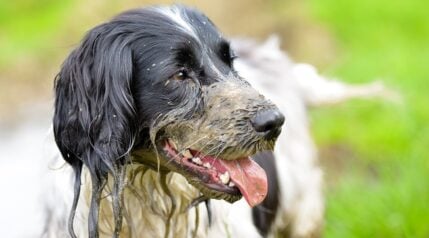As the summer approaches and the cold weather dog issues are long behind us, dog owners should be mindful of their pet’s well-being in hot weather.
Let’s take a look at some of the severe health conditions that can affect dogs during periods of excessive heat and how you can prevent your pet from succumbing to them. First of all, are some dogs more at risk from overheating than others?
Let’s find out about breeds and then look at different ways you can cool down your dog.
Dogs That Don’t Tolerate Hot Weather

To some extent, all dogs are vulnerable to the effects of excessive heat. That’s because dogs can’t cool themselves as efficiently as people can. Dogs are only able to sweat through their paws, using panting as their primary cooling method. So, you can see that a dog with a very thick, fluffy coat could overheat extremely quickly if left out in strong sunshine for prolonged periods.
Also, dogs with thin coats such as greyhounds can suffer from sunburn and heatstroke because they have no thick fur to protect their skin and act as a barrier to the sun’s UV rays.
Flat-Faced (brachycephalic) Dogs
Brachycephalic breeds such as Pekingese, Pugs, and Bulldogs have flat faces and short muzzles. That conformational quirk can lead to breathing difficulties, especially during hot weather. Panting can be difficult, meaning that flat-faced dogs find it harder to cool themselves than young pups with long muzzles.
Obese Dogs
Overweight dogs always struggle to cope when the hot summer months arrive. Being obese is not good for your pet, as the extra weight puts more strain on his body, and warm weather only adds to the pressure.
Thick-Coats
Dogs with thick coats will overheat much more quickly than short-haired breeds. So, if you own a Siberian husky or a German shepherd, your canine companion will struggle more during a heatwave than your neighbor’s Basenji.
Super-Sized Canines
Giant breeds often struggle to keep cool, purely because of their size. So, owners of large dogs such as Great Danes and Bernese mountain dogs will need to be vigilant during hot weather.
Seniors
Just like older people, senior pups and those with health conditions are more sensitive to very warm weather and tend to overheat more easily than young, healthy dogs.
Heat Loving Breeds

If you live in a region that enjoys a warm climate and typically has hot summers, you should choose a heat-tolerant breed of dog as your four-legged friend. Generally, breeds that have short, thin coats do best in the heat. Look for breeds that originate in areas with warm climates such as Chihuahuas, Basenjis, and Pharaoh Hounds. Also, members of the sighthound group are built to beat the heat such as Salukis, greyhounds, and whippets.
Hot Weather Advice
So, what steps can you take to keep your dog comfortable and safe during hot weather? Check out our top tips for keeping your dog cool this summer.
Stay Hydrated
First and foremost, always provide your dog with unlimited, fresh, clean water to drink, especially when the weather is very warm. Dehydration occurs very quickly in hot weather, so do be sure to give your dog as much water as he wants to drink.
Exercise
Always walk your dog early in the morning and late in the day when the sun has lost most of its power. Avoid walking your dog between 8 am and 6 pm if possible. Take water with you and offer your dog a drink at intervals during his walk.
Even though your dog might have other ideas, keep exercise sessions gentle and quiet. If you allow your dog to chase around after a ball, he will quickly get hot, and cooling down will take longer and be more difficult on hot days. Lively pups may be best confined to lead-only exercise until the temperature comes down.
If your dog’s usual exercise regime involves taking two very long walks every day, try giving him several shorter strolls instead until the weather cools down. Try investing in a dog umbrella! Although dog brollies are designed to keep pampered pooches dry on wet days, they also make great parasols for keeping the sun off your dog as you walk!
Keep Paws Protected
When the sun is intense, pavements and sand can become very hot, presenting a risk of burning your dog’s pads. There’s an easy test you can do to see if the underfoot temperature is suitable for your pet. Simply place the palm of your hand onto the ground and hold it there. If you can’t keep your hand there for more than five seconds, the pavement is too hot for your pet’s paws!
If you’re taking a trip to the beach on a hot day, invest in some protective booties for your dog to prevent his pads from being burned by the hot sand.
Be Careful In Cars
According to the PDSA, “Dogs Die in Hot Cars!” Remember, even if you park in the shade with the windows cracked open, your car will quickly become an oven. When the outside temperature is a balmy 700F, the temperature inside your car can reach a deadly 1200F in as little as 20 minutes. If you see a dog shut in a car on a hot day, call 911. You might just save a life.
Travel Safe
If you take a summer road trip with your dog, always make sure that he is safely restrained inside your vehicle either in a travel crate or by a dog safety harness. Did you know that being struck in the eye by a stone or other piece of debris while hanging out of a car window is a common cause of eye injuries in dogs? And some unfortunate pups have fallen from moving cars or been injured by a vehicle passing in the opposite direction.
Although Fido may enjoy the feel of the wind in his ears, never allow your dog to hang out of your car window!
Seek Shade & Cool Spaces
If you have a garden, make sure there’s a shady area where your dog can chill out. If you don’t have trees or shrubs to provide your dog with natural shade, invest in a pet gazebo, especially for your furry friend. A good way of creating a shady chill-out zone for your dog is to erect a shade sail over a corner of his yard space.
If your dog spends much of his time inside your home, you can create a cool place for him. An area with a tiled floor rather than warm carpet is perfect, and you could rig up a fan or crank up the air conditioning too.
If your home doesn’t have an area with cool tiles, provide your dog with a pet cooling mat. Pet cooling mats are filled with a special, pet-safe gel that immediately turns cold when activated by the pressure of the dog lying down.
If your dog has a kennel, move it out of the sun to a site that has shade all day so that your furry friend’s den stays cool.
Wet Dog

Most dogs love to play in water, and a pet’s paddling pool can make the perfect place for your dog to cool off. Pet paddling pools are specially designed to withstand the impact of scrabbling claws, and most are collapsible for easy assembly and storage.
Put the paddling pool in the shade so that the water isn’t heated by the sun, and always supervise your dog when he’s cooling down in the water. If you have a small dog, make sure that he can easily and safely get in and out of the pool (especially if he’s old), and keep the water level below your pet’s chest.
If your dog has access to the garden during the daytime, it’s a good idea to have a sprinkler playing while he’s outside so that your pet can cool himself off whenever he wants to.
Brush Undercoat
If you own a double-coated breed of dog, as the weather warms up and the days get longer, your extra-furry friend will start to shed his undercoat. Grooming your dog daily during this seasonal shedding period can be a great help to your pet in hot weather, as brushing helps to get rid of some of that insulating fluff, keeping him cooler.
Don’t shave your dog! Clipping away a thick coat might seem like a good idea, but a thick coat can act as protection for your dog from UV damage and actually helps to keep some of the sun’s heat out. Also, shaving a double coat will prevent the fur from growing back correctly, potentially leaving your pet shivering when the colder weather returns.
Some dog breeds do benefit from a summer trim, but always leave that job to a professional groomer.
Wear Sunscreen
Some dog breeds can be susceptible to sunburn. Thin-coated dogs that have white areas of fur all have skin that is extremely sensitive to the sun’s harmful UV rays. Vulnerable breeds include the Dalmatian, Dogo Argentino, English bulldog, and whippet.
The sun’s harsh rays easily penetrate the short or white coat, reaching the pink skin beneath and causing sunburn. Hairless breeds are also at risk, even those that are dark-colored. If you have a hairless breed, you should take extra care to keep him out of the sun altogether if possible.
You can protect your white or thin-coated pup with an application of canine sunscreen. Also, all dogs’ noses can quickly become dehydrated and sunburned, especially if you take a day trip to the beach. So, on summer days out, protect your pooch’s snout with regular applications of special doggy sunscreen.
Always use a dog-specific sunscreen product, not your own! Human shampoo, soap, and sun cream is not suitable for animals and could be harmful.
Other Protective Gear
If your dog doesn’t tolerate copious applications of sunscreen, you could deck him out in a special UV-screening jacket. These lightweight jackets have a reflective lining to repel the sun’s harmful rays. If you and your canine pal are planning on spending summer at the beach or out on a boat, you must take steps to protect your dog’s eyes from UV damage that can be caused by the sun reflecting off the water.
Investing in a set of “doggles” can keep your pup’s peepers protected from the sun and windblown sand and salt spray. And he’ll look super-cool too.
Hot Weather Dangers

Sometimes, despite their owners’ best efforts, dogs will succumb to the effects of heat. Here are some common health conditions that can occur during hot weather and advice on what to do if your pet is affected by any of these conditions.
Heatstroke
Heatstroke occurs when your dog’s body temperature is too high, usually following prolonged exposure to the sun. The signs of heatstroke can include:
- Temperature over 101.5 degrees F
- Excessive, rapid panting, as your dog tries to lose heat
- Dry mouth
- Drooling
- Diarrhea
- Vomiting
- Reddening and flushing of the skin on the inside of your dog’s ears
- Confusion
- Fainting
- Wobbliness and trouble walking
Heatstroke can be fatal, so always act fast!
After you’ve called your vet, take steps to cool your dog down. Here’s what you should do:
- Take your dog into a cool room where a fan or air conditioning is switched on.
- Wrap your dog in cold, wet towels. Pay particular attention to your pet’s tummy, underarm, and groin areas where the fur is thinnest and the skin is more readily accessible.
- Place your dog in front a fan it while you’re cooling him down (or use something to fan them down).
- If you have a pet thermometer, check your dog’s temperature every five minutes until it comes down to 103 degrees.
- Offer your dog some cool water, but don’t try to force him to drink if he doesn’t want to. If your vet thinks your dog is dehydrated, he may give him IV fluids.
Don’t try to cool your dog too quickly using ice, as this could send his body into shock.
Dehydration
If you make sure that your dog has access to plenty of fresh water, he should not become dehydrated. However, you need to know what to look out for, just in case.
The signs of dehydration include:
- Depression
- Lethargy
- Sunken eyes
- Dry mouth
To check if your dog is dehydrated, gently pinch a small fold of skin at the top of your pet’s neck. When you release the skin, it should return to its original position immediately. If the skin is slow to snap back, your dog could be dehydrated. Offer your dog clean, cool water right away.
Dehydration is a serious condition, and you should always contact your vet for advice immediately if you think your dog is dehydrated.
Pad Burn
Although dogs’ pads are pretty tough, they can be damaged by prolonged contact with hot surfaces such as sunbaked asphalt, concrete, and sand.
The signs of pad burns include:
- Limping or problems with walking
- Discolored, dark pads
- Biting or licking the feet
- Redness and visible blisters
- Cracked, clearly damaged pads
If you think your dog has pad burn, remove him from the hot surface immediately, even if you have to carry him. Flush your dog’s feet with cold water right away to stop the burning process. Contact your vet. Pad burn can result in infection, which could cause permanent damage to your dog’s feet.
Skin Cancer
Overexposure to the sun’s UV rays can cause damage and changes in your dog’s skin cells, which may eventually lead to skin cancer. Squamous cell carcinoma is not uncommon in dogs, but you must seek treatment for your pet urgently, as this form of cancer is aggressive.
Signs of skin cancer in dogs include:
- Skin changes on the tips of the ears or on the nose
- Wounds that don’t heal on the nose or tips of the ears
- The appearance of small, hard lumps on exposed areas of skin
Always consult your vet as soon you notice any of the above on your dog, especially if he has white fur and pink skin.
Final Thoughts
Summertime comes as a welcome relief from the cold, dark days of winter. Your dog will appreciate the good weather too, especially if you take him for fun days out to the beach or the lake. However, remember that your dog will find it harder to cool down than you do. Overheating and dehydration can lead to serious health problems for your pet. Follow the advice we’ve given in this guide so that you and your dog can look forward to a safe and happy summer in the sun.





